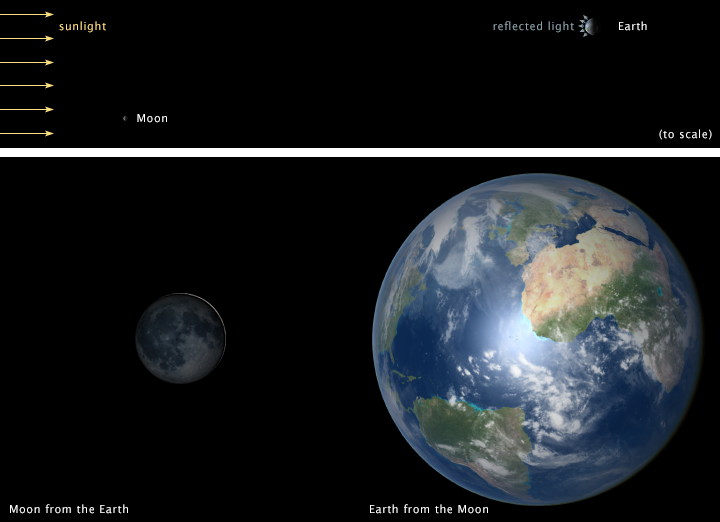


Tonight when the new Moon rises, or in the next few nights when the Moon is a slim crescent, go outside and look up. You might see Earth’s reflected light in the dim glow.
A new Moon occurs when all of the Sun’s light is reflected away from Earth, and the side of the Moon facing Earth is barely visible, as illustrated in the above figures. Sometimes the dark face of the Moon catches Earth’s reflected glow and returns that light. The dark face of the Moon has a faint shine, a ghostly version of a full Moon. The phenomenon is called earthshine. It tends to be brightest between April and June, though it does occur at other times of the year. The photo at the top of the page was taken by an astronaut on the International Space Station on July 31, 2011.
Earthshine is easiest to see around the time of a new Moon due to the position of Earth and the Moon in their orbits. The middle figure above shows the positions of the Earth and Moon on July 31, 2011, when the top photo was taken. The Sun is on the left side of the figure (out of the figure at this scale), with sunlight depicted with yellow arrows. The Moon is reflecting little to no sunlight in Earth’s direction; meanwhile, Earth is facing the Sun and reflecting plenty of light back in the direction of the Moon. An astronaut standing on the Moon after sunset would see a spectacular, fully lit Earth, as shown in the lower right figure. That reflected sunlight is in turn reflected back off the lunar surface to create earthshine.
Earthshine varies in strength throughout the year, since the light reflected from the Earth varies. Earth’s reflected light (albedo) is brightest in the Northern Hemisphere spring with a second, slightly smaller peak in the Southern Hemisphere spring.
Satellite measurements of energy reflected from the Arctic provide a picture of why earthshine peaks in the spring. During this period, the Northern Hemisphere is tilted towards the Sun and winter snow and ice are still on the ground in the higher latitudes. Because snow and ice reflect more light than vegetation or water, the spring is brighter than the summer or autumn, when there is much less snow and ice. During the winter, the Arctic receives very little sunlight and reflects less light. Clouds and sea ice contribute to the peak in the Southern Hemisphere.
Regardless of when you spot it, earthshine can be an inspiring site. The phenomenon is captured in Neil Peart’s lyrics for Earthshine, featured on Rush’s 2002 album Vapor Trails. Peart often writes about scientific themes, including Countdown from Signals, which recounts the maiden launch of Space Shuttle Columbia. Earthshine begins by describing the orbital mechanics that make the phenomenon possible: “On certain nights, when the angles are right…”
Astronaut Photograph ISS028-E-20073 was taken on July 31, 2011, and is provided by the ISS Crew Earth Observations Facility and the Earth Science and Remote Sensing Unit, Johnson Space Center. Diagrams by Robert Simmon, using the Celestia space simulation. Render of the moon by Ernie Wright, NASA GSFC Scientific Visualization Studio. “Earthshine” lyrics used by permission. Special thanks to Ken Fisher, NASA Johnson Space Center. Caption by Holli Riebeek.